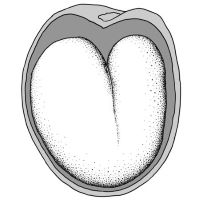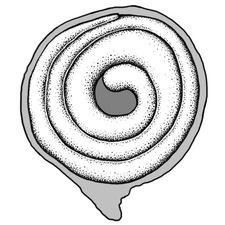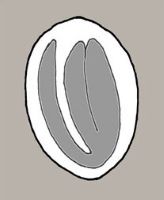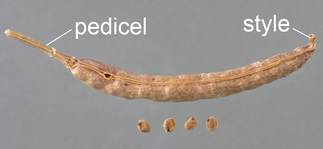Content is from Kirkbride et al. 2006Kirkbride et al. 2006:
Kirkbride JH, Jr, Gunn CR, and Dallwitz MJ. 2006. Family guide for fruits and seeds, vers. 1.0. Accessed September 2020-January 2022. URL: https://nt.ars-grin.gov/seedsfruits/keys/frsdfam/index.cfm ., without modification.
Updates are forthcoming.
Fruits: Pistil(s) compound; 1; 1-pistillate; with carpels united. Fruit pericarpium; simple, or schizocarpschizocarp:
usually dry fruit splitting between two or more locules to form distinct, indehiscent, usually one seeded segments; fruit derived from a single, superior or inferior, compound ovary; compare to mericarp ; amphisarcum, or berryberry:
; amphisarcum, or berryberry:
an indehiscent, fleshy fruit with one or a few to many seeds. The flesh may be homogenous throughout. Or, if the outer part is hard, firm, or leathery, referred to as an hesperidium. Septa are present in some, and the seeds may be arillate or with a fleshy testa. (Koeberlinia), or bilomentum (Maerua angolensis DC. & 4 families Brassicaceae, Capparaceae, Papaveraceae (listed as Fumariaceae), Goodeniaceae), or drupedrupe:
(Koeberlinia), or bilomentum (Maerua angolensis DC. & 4 families Brassicaceae, Capparaceae, Papaveraceae (listed as Fumariaceae), Goodeniaceae), or drupedrupe:
(indehiscent drupe) a fleshy, indehiscent fruit with one more hard pits enclosing seeds, derived from single, superior, simple or compound ovary; (dehiscent drupe) a fruit with a dry or fibrous to fleshy or leathery outer husk that early to tardily breaks apart (or opens), exposing one or more nutlike pits enclosing the seeds (Stixis (as Roydsia)), or urticle (not Spjut), or capsulecapsule:
(Stixis (as Roydsia)), or urticle (not Spjut), or capsulecapsule:
a dry, dehiscent fruit derived from a compound ovary ; achenarium; ceratium capsulecapsule:
; achenarium; ceratium capsulecapsule:
a dry, dehiscent fruit derived from a compound ovary (Spjut Fig. 19C); capsulecapsule:
(Spjut Fig. 19C); capsulecapsule:
a dry, dehiscent fruit derived from a compound ovary not inflated; capsulecapsule:
not inflated; capsulecapsule:
a dry, dehiscent fruit derived from a compound ovary without operculumoperculum:
without operculumoperculum:
a dehiscent cap (or lid) of a seed or fruit that opens during germination or dehiscence ; berryberry:
; berryberry:
an indehiscent, fleshy fruit with one or a few to many seeds. The flesh may be homogenous throughout. Or, if the outer part is hard, firm, or leathery, referred to as an hesperidium. Septa are present in some, and the seeds may be arillate or with a fleshy testa. indehiscent; berryberry:
indehiscent; berryberry:
an indehiscent, fleshy fruit with one or a few to many seeds. The flesh may be homogenous throughout. Or, if the outer part is hard, firm, or leathery, referred to as an hesperidium. Septa are present in some, and the seeds may be arillate or with a fleshy testa. without central placental mass; without persistent central column; not within accessory organ(s); with 2(–12)-carpellate; with carpels united; with carpels remaining united at maturity; without sterilesterile:
without central placental mass; without persistent central column; not within accessory organ(s); with 2(–12)-carpellate; with carpels united; with carpels remaining united at maturity; without sterilesterile:
lacking male and/or female reproductive parts; also, not producing fruit or seed
 carpels; apexapex:
carpels; apexapex:
the point farthest from the point of attachment, or the "tip" of an organ beaked, or not beaked; dehiscentdehiscent:
beaked, or not beaked; dehiscentdehiscent:
(v. dehisce) splitting open at maturity to release contents (of a fruit) , or indehiscentindehiscent:
, or indehiscentindehiscent:
not opening on its own, as in a fruit
 . Dehiscentdehiscent:
. Dehiscentdehiscent:
(v. dehisce) splitting open at maturity to release contents (of a fruit) unit seed(s). Dehiscentdehiscent:
unit seed(s). Dehiscentdehiscent:
(v. dehisce) splitting open at maturity to release contents (of a fruit) regularly; actively; elastically; and shedding seeds; without replumreplum:
regularly; actively; elastically; and shedding seeds; without replumreplum:
the rim, formed by the persistent placentas, and connected by a false septum in Brassicaceae fruits. The fruit valves are attached to this rim and separate from it in dehiscent fruits.
, or with replumreplum:
the rim, formed by the persistent placentas, and connected by a false septum in Brassicaceae fruits. The fruit valves are attached to this rim and separate from it in dehiscent fruits.
; fruit without centered partition attached to replumreplum:
the rim, formed by the persistent placentas, and connected by a false septum in Brassicaceae fruits. The fruit valves are attached to this rim and separate from it in dehiscent fruits.
, or with thin centered partition attached to replumreplum:
the rim, formed by the persistent placentas, and connected by a false septum in Brassicaceae fruits. The fruit valves are attached to this rim and separate from it in dehiscent fruits.
. Epicarpepicarp:
outer layer of fruit wall or pericarp, if divided into layers; note here used synonymously with exocarp black, or brown (all shades); durable; without armature; without wing(s); without apicalapical:
black, or brown (all shades); durable; without armature; without wing(s); without apicalapical:
at or pertaining to the end of the seed or fruit distal from its point of attachment (i.e., base)
respiratory hole. Mesocarpmesocarp:
the middle layer of the pericarp, if divided into layers present, or absent. Endocarpendocarp:
present, or absent. Endocarpendocarp:
the inner layer of the pericarp, if divided into layers present, or absent; not separating from exocarpexocarp:
present, or absent; not separating from exocarpexocarp:
outer layer of fruit wall or pericarp, if divided into layers; note here used synonymously with epicarp ; thin; not splitting into 1-seeded pyrenes; smooth; without wing; without operculumoperculum:
; thin; not splitting into 1-seeded pyrenes; smooth; without wing; without operculumoperculum:
a dehiscent cap (or lid) of a seed or fruit that opens during germination or dehiscence ; without secretory cavities; without mechanism for seedling escape; without grooves; without longitudinallongitudinal:
; without secretory cavities; without mechanism for seedling escape; without grooves; without longitudinallongitudinal:
of or relating to length or the lengthwise dimension
ridges. Funiculusfuniculus:
(alt. funicle) stalk connecting the ovule (later seed) to the ovary (later fruit) placenta short; short without seed bearing hookswith hooks:
short; short without seed bearing hookswith hooks:
bristles or spines with curved or backwards pointing tips, or with secondary bristles along their length (retinacula); not persisting in fruit after seed shed.
(retinacula); not persisting in fruit after seed shed.
Seeds: Arilaril:
(broad sense) appendicular structure that wholly or partly envelops a seed and is produced from or a modification of the funicle, raphe, or outer integument; usually fleshy or pulpy, sometimes spongy or tufted-capillate, often brightly colored absent. Seed larger than minute; 1 to less than 5 mm long, or 5 to less than 10 mm long; 2.5–6 mm long; reniformreniform:
absent. Seed larger than minute; 1 to less than 5 mm long, or 5 to less than 10 mm long; 2.5–6 mm long; reniformreniform:
2D or 3D shape—kidney-shaped , or angularangular:
, or angularangular:
2D shape—having sides that meet at acute or obtuse angles
; in transection compressedcompressed:
flattened; in grasses, used to denote compression (not necessarily flattened) either laterally or dorsiventrally
; not bowl shaped; not nutlike; without winglike beakbeak:
a usually firm, terminal appendage, sometimes tapered ; without caudatecaudate:
; without caudatecaudate:
tapering to a long, tail-like appendage appendage(s); at maturity with food reserves; with endosperm and perispermperisperm:
appendage(s); at maturity with food reserves; with endosperm and perispermperisperm:
seed nutritive tissue comparable to the endosperm, but derived from the nucellus (maternal tissue)
; without canavanine. Sarcotestasarcotesta:
pulpy or fleshy outer layer of the seed coat, simulates aril absent. Testatesta:
absent. Testatesta:
seed coat
 present, or absent (seeds often sunken in pulpy flesh of fruit); without embryo surrounded and capped by viscid tissue; without fleshy or leatheryleathery:
present, or absent (seeds often sunken in pulpy flesh of fruit); without embryo surrounded and capped by viscid tissue; without fleshy or leatheryleathery:
texture—moderately thick, tough, and very pliable
layer over hard layer; surface unsmooth; surface with discreet raised features, or merged raised features; surface tuberculatetuberculate:
surface relief—bearing small, warty, swelling, rounded, or variously shaped projections ; surface laterally ribbedribbed:
; surface laterally ribbedribbed:
surface relief—wide, prominent, linear ridges that are generally rounded and longitudinally situated on the surface , or ridgedridged:
, or ridgedridged:
surface relief—raised, thick ridges, sharp edged or rounded, usually in a series that may cover the entire surface , or striatestriate:
, or striatestriate:
surface relief—having fine, parallel lines, grooves or ridges ; with crease or line separating cotyledons from hypocotyl-radicle; with notch along margin where cotyledons from hypocotyl-radicle tip approaching each other; without glands; without bristles; glabrousglabrous:
; with crease or line separating cotyledons from hypocotyl-radicle; with notch along margin where cotyledons from hypocotyl-radicle tip approaching each other; without glands; without bristles; glabrousglabrous:
without hairs
; without wings; without collar; without operculumoperculum:
a dehiscent cap (or lid) of a seed or fruit that opens during germination or dehiscence ; colored; monochrome; brown (all shades), or black; not becoming mucilaginousmucilaginous:
; colored; monochrome; brown (all shades), or black; not becoming mucilaginousmucilaginous:
resembling mucilage; moist and sticky
when wetted. Endosperm development nuclear; scant; fleshy; smooth; with oils; without fatty acid containing cyclopropene; without apicalapical:
at or pertaining to the end of the seed or fruit distal from its point of attachment (i.e., base)
lobes; without chlorophyll; without isodiametric faceted surface; without odor. Perispermperisperm:
seed nutritive tissue comparable to the endosperm, but derived from the nucellus (maternal tissue)
often scanty; opaqueopaque:
not transmitting light
. Embryo differentiated from food reserve; well developed; 1 per seed; completely filling testatesta:
seed coat
 (no food reserve), or nearly filling testatesta:
(no food reserve), or nearly filling testatesta:
seed coat
 (trace or scanty food reserve); at one end of seed not extending into a depression or cup; bentbent:
(trace or scanty food reserve); at one end of seed not extending into a depression or cup; bentbent:
(of embryo) embryo is bent at an acute, V-shaped angle with the ends close together and generally thick cotyledons , or flatly coiledcoiled:
, or flatly coiledcoiled:
(of embryo) linear embryo is very long and bent to form a coil whereby one end of the embryo is on the outside and the other end near the middle of the seed (circinatecircinate:
(circinatecircinate:
3D shape—terete and rolled downward from the apex in a tight coil
), or annularannular:
3D shape—forming a ring , or arcuate; without coleorhiza; without simmondsin; with cotyledons containing oils; with stomata; not green; with 2 or more cotyledons. Cotyledons 2; well developed; 0.3–0.7 times length of embryo; 1 times wider than hypocotyl-radicle; not concealing hypocotyl-radicle; accumbent to hypocotyl-radicle, or incumbentincumbent:
, or arcuate; without coleorhiza; without simmondsin; with cotyledons containing oils; with stomata; not green; with 2 or more cotyledons. Cotyledons 2; well developed; 0.3–0.7 times length of embryo; 1 times wider than hypocotyl-radicle; not concealing hypocotyl-radicle; accumbent to hypocotyl-radicle, or incumbentincumbent:
(of cotyledons) having the dorsal side of one cotyledon resting against the radicle to hypocotyl-radicle; moderately thick; once-folded, or twice-folded, or circinatecircinate:
to hypocotyl-radicle; moderately thick; once-folded, or twice-folded, or circinatecircinate:
3D shape—terete and rolled downward from the apex in a tight coil
, or flat (rarely); smooth; with apicesapex:
the point farthest from the point of attachment, or the "tip" of an organ entire; with margins separate; basally entire; equal in size; not punctatepunctate:
entire; with margins separate; basally entire; equal in size; not punctatepunctate:
surface relief—dotted with pits or with translucent, sunken glands or with colored dots, similar to pitted dotted. Hypocotyl-radicle well developed; curvedcurved:
dotted. Hypocotyl-radicle well developed; curvedcurved:
(of embryo) linear embryo is curved into an arch or horseshoe with the ends far apart ; not thickened.
; not thickened.
Cronquist: Arillate for three genera now moved to other families: Emblingia - Emblingiaceae; Physena - Physenaceae; Calyptrotheca - Portulacaceae. Iltis (1999) moved Setchellanthus to its own family, Setchellanthaceae. Hence the reduction of Capparaceae by 1 genus & 1 species. Goldberg recognized Capparaceae & Pentadiplandraceae. Unlike Brassicaceae, Capparaceae usually does not have a partition in the capsulecapsule:
a dry, dehiscent fruit derived from a compound ovary . Capparoideae: Fruit indehiscentindehiscent:
. Capparoideae: Fruit indehiscentindehiscent:
not opening on its own, as in a fruit
 berryberry:
berryberry:
an indehiscent, fleshy fruit with one or a few to many seeds. The flesh may be homogenous throughout. Or, if the outer part is hard, firm, or leathery, referred to as an hesperidium. Septa are present in some, and the seeds may be arillate or with a fleshy testa. or drupedrupe:
or drupedrupe:
(indehiscent drupe) a fleshy, indehiscent fruit with one more hard pits enclosing seeds, derived from single, superior, simple or compound ovary; (dehiscent drupe) a fruit with a dry or fibrous to fleshy or leathery outer husk that early to tardily breaks apart (or opens), exposing one or more nutlike pits enclosing the seeds without replumreplum:
without replumreplum:
the rim, formed by the persistent placentas, and connected by a false septum in Brassicaceae fruits. The fruit valves are attached to this rim and separate from it in dehiscent fruits.
- Capparis etc.; Cleomoideae: Fruit dehiscentdehiscent:
(v. dehisce) splitting open at maturity to release contents (of a fruit) cruciferous siliquesilique:
cruciferous siliquesilique:
(includes silicle) a fruit derived from a 2-loculed, single, superior compound ovary in which the two halves of the fruit split away from a persistent partition (around the rim of which the seeds are attached) with replumreplum:
with replumreplum:
the rim, formed by the persistent placentas, and connected by a false septum in Brassicaceae fruits. The fruit valves are attached to this rim and separate from it in dehiscent fruits.
- Cleome etc.; Podandrogynoideae: Fruit dehiscentdehiscent:
(v. dehisce) splitting open at maturity to release contents (of a fruit) capsulecapsule:
capsulecapsule:
a dry, dehiscent fruit derived from a compound ovary with no replumreplum:
with no replumreplum:
the rim, formed by the persistent placentas, and connected by a false septum in Brassicaceae fruits. The fruit valves are attached to this rim and separate from it in dehiscent fruits.
- Podandrogne; Dipterygioideae: Fruit 1–2-seeded nutletnutlet:
˜achene
or samarasamara:
a winged, indehiscent, dry fruit containing a single (rarely two) seed(s) - Dipterygium.
- Dipterygium.
Literature specific to this family: Iltis, H.H. 1999. Setchellanthaceae (Capparales), a new family for a relictual, glucosinolate-producing endemic of the Mexican deserts. Taxon 48:257–275.
General references: Baillon, H.E. 1866–95. Histoire des plantes, 13 vols. Hachette & Co., Paris, Corner, E.J.H. 1976. The seeds of Dicots, esp. vol. 2. Cambridge University Press, New York, Cronquist, A. 1981. An integrated system of classification of flowering plants, 1,262 p. Columbia University Press, New York, Engler, A. & K. Prantl. 1924 and onward. Die Natürlichen Pflanzenfamilimien. W. Engelman, Leipzig, Gaertner, J. 1788–1805. De fructibus et seminibus plantarum. The Author, Stuttgart, Goldberg, A. 1986 (dicots) & 1989 (monocots). Classification, evolution, and phylogeny of the familes of Dicotyledons. Smithsonian Contr. Bot. 58 for dicots (314 pp.) & 71 for monocots (74 pp.). [Goldberg's illustrations are reproduced from older publications and these should be consulted], Gunn, C.R., J.H. Wiersema, C.A. Ritchie, & J.H. Kirkbride, Jr. 1992 & amendments. Families and genera of Spermatophytes recognized by the Agricultural Research Service. Techn. Bull. U.S.D.A. 1796:1–500, LeMaout, E. & J. Decaisne. 1876. A general system of botany, 1,065 p. Longmans, Green, & Co., London, Mabberley, D.J. 1987. The plant-book, 706 p. Cambridge University Press, Cambridge, Martin, A.C. 1946. The comparative internal morphology of seeds. Amer. Midl. Naturalist 36:513–660, and Spjut, R.W. 1994. A systematic treatment of fruit types. Mem. New York Bot. Gard. 70:1–182.